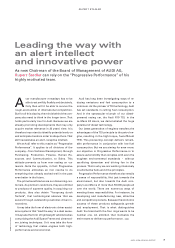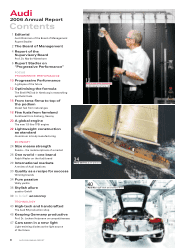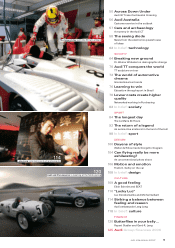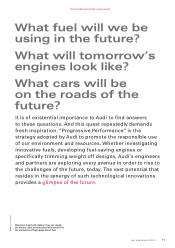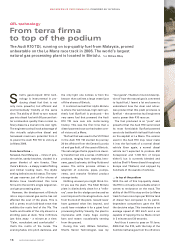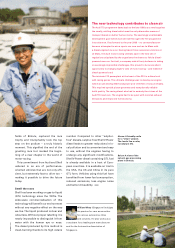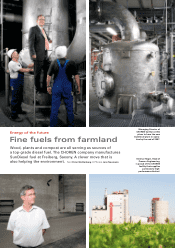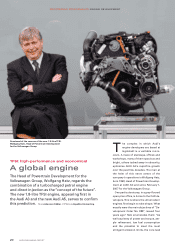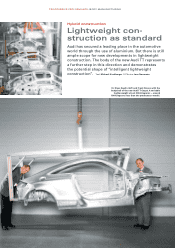Audi 2006 Annual Report Download - page 18
Download and view the complete annual report
Please find page 18 of the 2006 Audi annual report below. You can navigate through the pages in the report by either clicking on the pages listed below, or by using the keyword search tool below to find specific information within the annual report.
The Audi R10 TDI, running on top-quality fuel from Malaysia, proved
unbeatable on the Le Mans race track in 2006. The world’s largest
natural gas processing plant is located in Bintulu. Text William Whey
GTL technology
From terra firma
to top of the podium
PROGRESSIVE PERFORMANCE: POWERED BY SYNFUEL
16 AUDI 2006 ANNUAL REPORT
Shell’s gas-to-liquid (GTL) tech-
nology is instrumental in pro-
ducing diesel fuel that is not
only more powerful, but efficient and
environmentally friendly at the same
time. The ability of Shell to turn natural
gas into diesel fuel with 50 percent bet-
ter combustion quality than normal re-
finery diesel is a marvel in its own right.
The engineers at Audi took advantage of
this virtually sulphur-free diesel and
harnessed maximum potential from it
to power the Audi R10 TDI to victory at
Le Mans 2006.
From terra firma …
Sarawak, East Malaysia – miles of pris-
tine white, sandy beaches, cloaked in a
green blanket of rain forests. Then
there’s Bintulu – a sleepy coastal fishing
and timber trading town. The idyllic
setting belies its world status. The natu-
ral gas reserves just off the shores of
Bintulu have transformed this terra
firma into the world’s single largest nat-
ural gas processing plant.
However, the development of Bintulu
into a major natural gas centre has not
affected the soul of the place. This is
still a pretty much laid-back town that
exhibits the rustic feel of the 70s. The
hustle and bustle of the city slows to a
strolling pace at dusk. Time in Bintulu
just ticks away – a minute at a time.
“Calm, nonchalant and comfortable” –
that’s the motto of the locals. The
evening fades into pitch darkness, and
the only light one notices is from the
beacon that outlines a large vessel just
off the shores of Bintulu.
It is almost surreal that idyllic Bintulu
is where the world-class, high-tech syn-
thetic fuel (SynFuel) is produced – the
very same fuel that powered the Audi
R10 TDI race cars into motor-racing
history. This was the first time that a
diesel-powered race car had taken over-
all victory at Le Mans.
The fuel that was used in the V12 fitted
in the Audi R10 TDI started its journey
20 km offshore from the Central Luconia
oil and gas field, off the coast of Bintulu.
The natural gas that is piped in is clever-
ly transformed into a series of different
products, ranging from naphtha, kero-
sene, gasoil, solvents, drilling fluids and
waxes. The entire process utilises a
labyrinth of concrete, pipes, pumps,
vents, and massive finished product
storage tanks.
Nothing unusual you might think. Un-
til you see the plant. The Shell Bintulu
plant is distinctively clean for a “refin-
ery”; even the bio-sludge can be used as
a soil improver for local agriculture. Just
from the look of the plant, I would never
have guessed what lies beyond, and
could have mistaken it for a giant food
processing facility. Visually, the plant is
impressive with many huge cooling
fans and steam occasionally venting
from the ground.
During this visit, Willem Scholten,
Shell’s Senior Technologist, was my
“tour guide”. Thanks to his vivid descrip-
tion of how the natural gas is converted
to liquid fuel, I learnt a lot and came to
understand how the clear and odour-
less product that this plant produces is
SynFuel – the same that Audi engineers
use to power their R10 race car.
The fuel produced is so “pure” and
powerful that the Audi R10 summoned
its most formidable SynFuel-powered
cars to do battle with its fossil fuel rivals
on the asphalt at Le Mans. The version
used in the Audi R10 may never make
it into the fuel tank of a normal diesel
vehicle (then again, a normal diesel
vehicle isn’t expected to produce 650
horsepower and 1,100 Nm of torque
either!), but is currently blended and
sold as Shell V-Power diesel throughout
Europe and Thailand, and enjoyed by
hundreds of thousands of vehicles.
… to top of the podium
With the aid of this top-quality diesel,
the R10 is virtually untouchable when it
comes to endurance on the track. The
ability of the R10 to stay on the Le Mans
track for two more laps per 90-litre tank
of diesel fuel compared to its petrol-
dependent competitors gave the R10
the decisive edge. This translates to an
average speed of 233 km/h and a car
capable of lapping the Le Mans circuit
in 3 minutes and 30 seconds.
And thus it came to pass on 18 June,
2006 that the R10, with the help of the
humble methane gas from the off-shore



